

| Circe
| Wednesday, February 17, 2010 First, I promised a better photo of the completed hardware risers: |
|
Yesterday's glue-ups for the cabinet doors had cured sufficiently to allow me to unclamp them, freeing up my clamps so I could glue the remaining doors. I was auditioning a new epoxy adhesive, and it seemed to take longer to cure than my usual shop-made epoxy adhesive, so I set all the doors in my utility room near the oil burner for some extra heat to help the process along. |
 |
|
I spent the day working on several different onboard systems, beginning with the diesel fuel system. I secured adapter fittings and brass hose barbs to the fuel filter assembly, and then determined the filter's location in the engine room. The removable design of the starboard engine box precluded mounting anything on that side, so I had to find space on the port side for both the fuel filter and the raw water sea strainer. Fortunately, there was plenty of room for both. With the basic locations determined, I marked cabinet through the slots on the fuel filter and installed a pair of threaded inserts in the cabinet, into which I secured the filter using machine screws. |
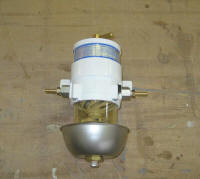
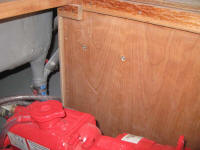
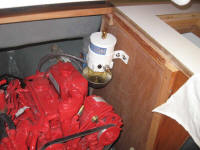 |
|
With the filter in place, I determined the best location for the bronze sea strainer, allowing for hose access and for the tee fitting for the galley salt water supply, and marked for the strainer's mounting screws. I installed the screws and tested the fit. |
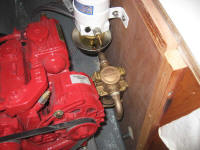 |
|
Before installing the strainer permanently, however, I chose to install the two battery cables on the engine, since access to their connection points would be hindered by the sea strainer once it was installed. I made up lug ends for both the positive cable to the starter, and the negative cable to the engine ground, and secured each cable in its respective place. I ran the cables through the access holes to the electrical panel location, since both cables would have to end up there, but left the cables long and loose at the moment, since I didn't yet know how I'd be routing them along the way. All I wanted was to have their connections to the engine complete at this stage. |
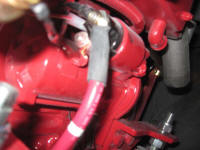
 |
|
With the cables connected, I continued with the installation of the sea strainer, as well as the related hoses to the engine, from the raw water intake seacock, and for the galley sink supply, securing the various hoses as required throughout their runs. |
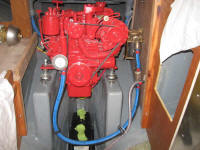
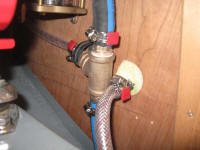
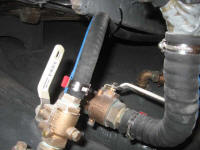 |
|
I ran lengths of 1/4" fuel hose to and from the fuel filter and engine as supply and return lines, running between the engine room and the cockpit locker where the fuel tank would be mounted, and securing the lines along the cockpit well as needed. I installed white hose over the fuel line in places where there might be a chafing issue. I ran a supply hose from the fuel filter across to the fuel supply fitting on the starboard side of the engine. For the moment, I left the hoses to the cockpit locker long, pending the fuel tank installation, and also left the hoses disconnected at their engine ends, since I didn't have the correct size hose clamps in stock. I'd make up those final connections when the clamps arrived tomorrow. |
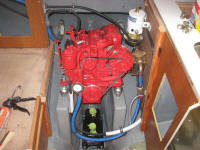
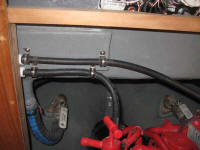
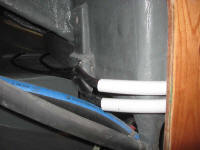 |
| Meanwhile, I prepared the fuel tank for installation by installing a pair of stainless steel adapters to the aluminum fittings on the tank itself, and then 90° brass hose nipples for the fuel supply and return connections. I held off on installing the tank right away since I wanted to mount the fuel fill deck fitting first; this I wanted to give another day or two worth of cure time for the new paint before I worked with it. |
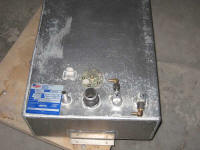 |
|
To prepare for the electrical wiring, I installed a series of cable tie mounts throughout the boat along known wiring runs, including along the hull sides in the main cabin, forward and aft to the running light locations on the pulpits, and elsewhere as I thought required. |
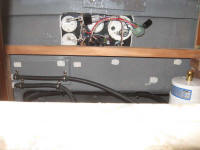
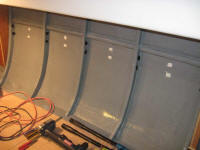 |
|
There were some plumbing loose ends with the potable and waste water tanks, so I determined to complete those. The potable water tank required a fill hose leading to the deck plate, so I located a suitable length of hose, drilled a hole in the plywood platform for access to the tank, and installed the hose as needed. |
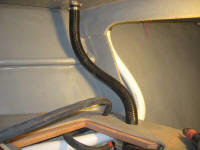 |
|
Both tanks required vent fittings and vent hoses. Earlier, I'd ordered some bronze through hull vents for each tank, and from inside the boat I determined the location for these vents and drilled small pilot holes through the hull from inside to mark the locations. Then, outside the boat, I drilled the larger hole required for the two vents, and installed the vents with sealant, securing it from inside with the supplied nut. |
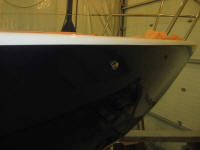
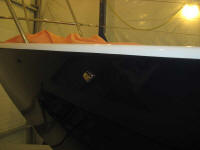 |
|
Finally, I secured 5/8" vent hose for each tank. |
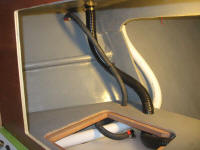
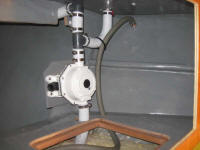 |
|